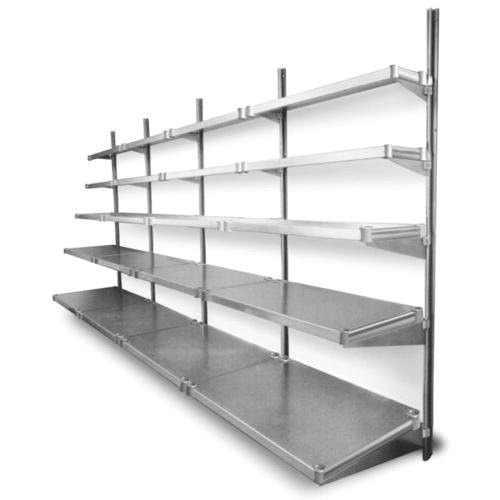Display Rack
Product Details:
- Product Type ms
- Feature High Quality
- Color Silver
- Metal Type Steel
- Layer 5 Shelves
- Surface Treatment Polishing
- Usage Market Commercial Industrial
- Click to View more
Display Rack Price And Quantity
- 100 Kilograms
- 110.0 INR/Kilograms
Display Rack Product Specifications
- Polishing
- Market Commercial Industrial
- Silver
- ms
- High Quality
- Steel
- 5 Shelves
Display Rack Trade Information
- INDIAN
- Cash in Advance (CID) Cash Advance (CA)
- 1000 Kilograms Per Day
- 3 Days
- No
- Sample costs shipping and taxes has to be paid by the buyer
- Asia
- All India
Product Description
A display rack, also known as a display stand, retail display, or merchandise display, is a versatile piece of equipment designed to showcase products in a visually appealing and organized manner. Its primary purpose is to attract customer attention, highlight specific items, and ultimately drive sales in retail environments, showrooms, exhibitions, and even in some home settings.
Description:
Display racks come in a vast array of designs, sizes, and materials, making them adaptable to various product types and aesthetic requirements. They can range from simple, utilitarian shelves to elaborate, multi-tiered structures with integrated lighting and branding.
Key characteristics often include:
- Visibility: Designed to maximize product visibility from different angles, often with open fronts or transparent materials.
- Organization: Provides clear segmentation and arrangement for products, preventing clutter and making it easy for customers to browse.
- Durability: Constructed from materials that can withstand the weight of merchandise and the rigors of a retail environment.
- Aesthetics: Often designed to complement the brand image or store dcor, using attractive finishes, colors, and shapes.
- Versatility: Many racks are modular or adjustable, allowing for changes in product display as inventory or promotions change.
- Branding Opportunities: Can incorporate signage, logos, and promotional graphics to reinforce brand messaging.
Common types of display racks include:
- Shelf Displays: Basic shelving units, often adjustable, for various products.
- Pegboard/Slatwall Displays: Panels with holes or grooves to attach hooks, shelves, or bins, offering high flexibility.
- Gondola Shelving: Freestanding, double-sided units commonly found in supermarkets and convenience stores.
- Countertop Displays: Smaller units designed to sit on checkout counters or tables for impulse buys.
- Floor Displays: Larger, freestanding units often placed in high-traffic areas.
- Literature Racks: Specifically designed to hold brochures, magazines, or flyers.
- Garment Racks: Used for hanging clothing.
- Wire Racks: Lightweight and often used for snacks, chips, or seasonal items.
- Rotating Displays: Allow customers to spin the unit to view all products.
Specifications:
The specifications of a display rack vary significantly based on its type, intended use, and desired features. Here are common specifications to consider:
1. Dimensions: * Height: Overall height from the base to the top. * Width: Overall width from side to side. * Depth: Overall depth from front to back. * Shelf/Hook Dimensions: Individual dimensions of shelves, pegboard, or slatwall sections. * Tier/Level Spacing: Adjustable or fixed distance between shelves or levels.
2. Material: * Metal: Steel (powder-coated, chrome-plated, stainless steel), aluminum (lightweight, corrosion-resistant). * Wood: MDF (Medium-density fiberboard), plywood, solid wood (various finishes like laminate, veneer, paint). * Plastic: Acrylic (clear, colored), PVC, ABS (durable, lightweight, often used for molded parts). * Glass: Tempered glass for shelves or display cases. * Wire: Steel wire, often coated for durability. * Combination: Many racks use a combination of materials (e.g., metal frame with wooden shelves).
3. Load Capacity: * Per Shelf/Level: Maximum weight (in kg or lbs) that each individual shelf or level can safely hold. * Overall: Total maximum weight the entire rack can support.
4. Design and Configuration: * Number of Tiers/Shelves: How many levels for product display. * Adjustability: Whether shelves, hooks, or other components are adjustable in height or position. * Mobility: * Stationary: Fixed in one place. * Portable: Lightweight and easy to move. * With Casters/Wheels: For easy repositioning. * Assembly: * Knock-down (KD): Ships disassembled for cost-effective transport, requires assembly. * Pre-assembled: Ships ready to use. * Display Mechanism: Shelving, pegboard, slatwall, hooks, bins, hangers, waterfalls, etc. * Branding Elements: Space for signage, header boards, side panels for graphics, LED screens. * Lighting: Integrated LED strips, spotlights, or ambient lighting options. * Security Features: Lockable cabinets or cases for high-value items.
5. Finish: * Powder Coating: Durable, colored finish (common for metal). * Chrome Plating: Shiny, metallic finish. * Brushed/Polished: For stainless steel or aluminum. * Laminate/Melamine: Durable surface for wood products. * Paint/Stain: For wood products. * Clear Coat: To protect natural wood or metal.
6. Weight: * Net Weight: Weight of the rack itself. * Gross Weight: Weight of the rack including packaging (important for shipping).
7. Special Features: * Interchangeable Components: Allows for different display configurations. * Built-in Storage: Drawers or cabinets for extra stock. * Power Outlets: For electronic products or digital signage. * Customization Options: Ability to order racks with specific dimensions, colors, or branding.
By considering these specifications, businesses can select or design display racks that effectively meet their merchandising needs and enhance the customer experience.

Price:
- 50
- 100
- 200
- 250
- 500
- 1000+





 Send Inquiry
Send Inquiry Send SMS
Send SMS